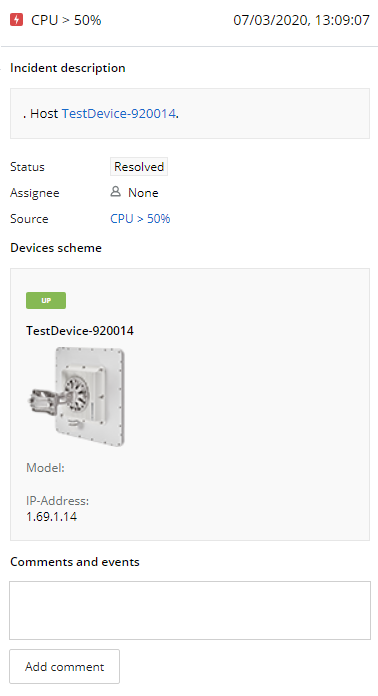A NEXT user can obtain a list of all incidents with wireless devices and links for hit visibility area at the "Incidents" section.
The section includes two key areas:
- Incidents list - all incidents of devices and links in the user's visibility area are displayed here.
- Incident card side view - if this area is open, an incident card with detailed information will be displayed without hiding the list of incidents. If the area is hidden, then the selected incident card will be opened, the list of incidents will be hidden.
Incidents review
The incidents list is presented in a table with the following columns:
- Incident - it displays the title and severity of the rule according to which the incident was created.
- Status - current incident status. Possible statuses are described in the Incident management article.
- Device - the device for which the incident was generated.
- Date - дата и время создания инцидента.
By default, all incidents are sorted by date, new incidents will be displayed first.
Incident card
A card contains the following detailed information:
- "Description" - the device or link for which the incident was generated will be displayed here. Also there is a description from appropriate rule.
- "Status" - current incident status.
- "Assignee" - user responsible for elimination of an incident reasons.
- "Source" - rule title.
- "Scheme":
- Device incident - additional information about the device, including its status, model and IP address.
- Link incident - additional information about the devices connected by the link for which the incident is generated.
- "Comments" - comments added by engineers to this incident.
Incident processing
Incident processing - one of the incident lifecycle stages (see Incident management). An incident is processed when a responsible person is assigned to it:
- Superadmin and Admin users can assign incidents to other users to which visibility area the device with incident generated is belongs to. Superadmin user can not become an assignee.
- The user can assign an incident to himself, thereby making himself responsible for eliminating the cause.
To accept an incident into work, the user must click on the "Take on" button in the incident card. It will lead to the following changes:
- Incident status will change to "In service".
- The incident will be assigned to the user, which will be reflected in the "Assignee" field.
If the incident rule contains the conditions for its automatic closure, then the incident will be automatically closed after eliminating the cause. If the engineer eliminated the incident cause, but the rule does not have the conditions for its automatic closure, then the user can manually change the status of the incident to "Resolved". If the user does not manually change the status, then the incident will become obsolete with the status "Aged".
Engineers can leave comments in the incident card that will be visible to other engineers whose visibility area includes a particular device.
